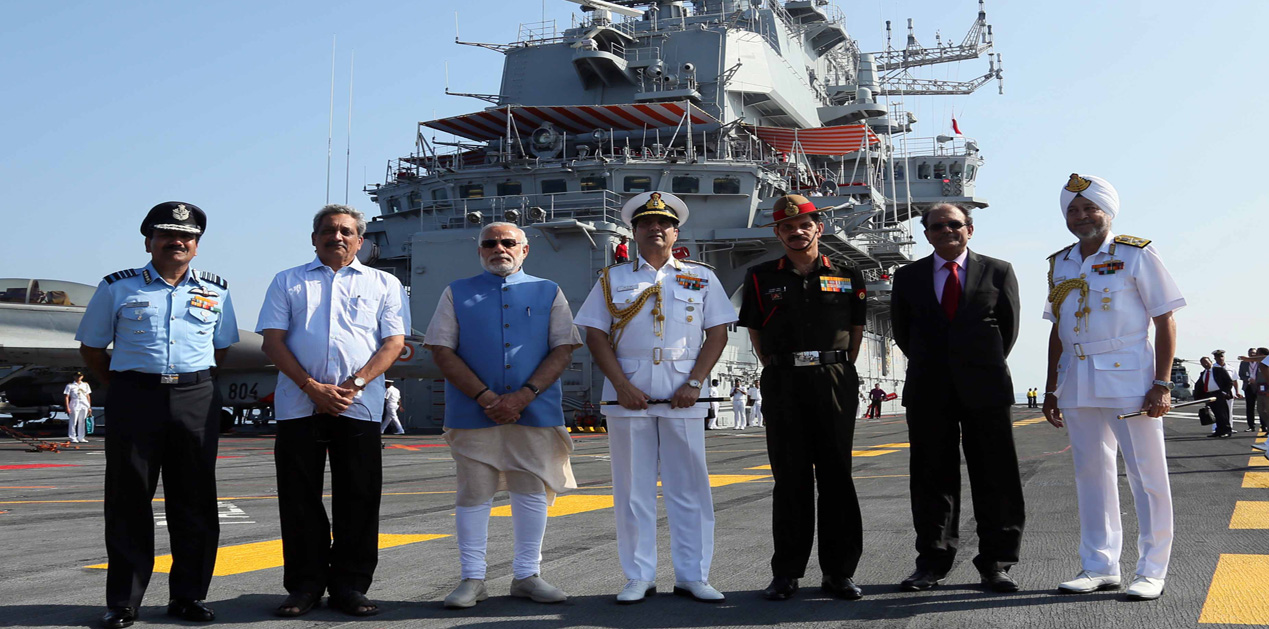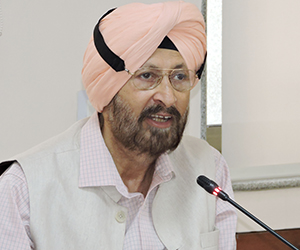Inconsistent Policy Formulation
All national-level endeavours must be based on a clear sense of purpose. The idea is elemental, but one that is little appreciated and often ignored. Does India have a comprehensive, clearly enunciated national security strategy? Does India need such a strategy in its nuclear weapons-dominated, unstable external security environment, and an internal security environment vitiated by foreign-sponsored insurgencies? The answer to the first question is definitely 'no'; and, to the second, an unambiguous 'yes'.
Indian defence analysts have for long lamented the lack of strategic vision and national security strategy. With his characteristic frankness, K. Subrahmanyam minced no words in bluntly stating two decades ago: "It is now well recognised all over the world that India does not have a tradition of strategic thinking... mainly due to the incapacity of our political leaders and top civil servants to take a long-term view of national security. This is compounded by their consequent failure in giving a lead to the armed forces in preparing the country to face its long-term need for defence preparedness."
Indian policy planners have traditionally fought shy of formally articulating the country's defence and national security policies. Perhaps this reticence owes its origins to an innate sense of refraining from hurting the sensibilities of India's adversaries and neighbours. In its Nineteenth Report, the Estimates Committee had recommended that the country should have a formal National Security Doctrine. When the Standing Committee on Defence (1995-96) in the Tenth Lok Sabha enquired about the action taken on this recommendation, the Defence Secretary had replied: "... there is a policy; the only thing is that it is not written down as a separate document and published as such... As a matter of policy we have not published such a document and the Government has not been in favour of publishing a separate document. It is only the United States in my knowledge which annually publishes a document called National Security Doctrine. Non-publication of the document does not mean in any way non-existence of policy."
Replying to the debate in the Lok Sabha on the Demands for Grants of the MoD, on May 10, 1995, Prime Minister P. V. Narsimha Rao, who was also the Defence Minister, had stated: "We do not have a document called India's National Defence Policy. But we have got several guidelines which are followed, strictly followed and observed... This policy is not merely rigid in the sense that it has been written down, but these are the guidelines, these are the objectives, these are the matters which are always kept in view while conducting our defence policy..." Responding to a question from the Standing Committee on Defence (Sixth Report, Standing Committee on Defence (1995-96), Tenth Lok Sabha, March 1996), the MoD stated: "... although there has been no specifically written document called India's National Defence Policy, yet it has been articulated clearly and unambiguously through various policy statements over the years. The policy articulated since independence is as follows: That our military capability is to be so directed to ensuring the defence of national territory over land, sea and air encompassing among others the inviolability of our land borders, island territories, offshore assets and our maritime trade routes. Government have repeatedly made it clear that it is not our objective to influence/interfere/dominate (the) region on the basis of military strength."
Similarly, the Ministry of External Affairs (MEA) had averred in its Annual Report for 1998-99: "We view foreign policy as an integral part of the larger effort of building the nation's capabilities: through economic development, strengthening social well-being and the quality of life and of protecting India's sovereignty, territorial integrity and security, not only in its defence and economic aspects, but in the widest strategic sense of the term." It went on to say that India's external relations are guided by "well-established principles" which have formed the "basis of our foreign policy for decades" and "enjoy a broad national consensus, thus providing a strong foundation of stability and continuity." However, the report did not spell out what those principles are in specific terms and how they translate practically into furthering national interests and objectives.
It is due to this lack of a long-term national security perspective and the failure to initiate a public debate for the formulation of a national consensus on the vital interests, national security objectives and a synergised national security strategy, that the security pendulum had swung between the interventionist "Indira Doctrine" of the 1970’s and 1980’s on one end and the conciliatory "Gujral Doctrine" of the mid-1990s on the other. The Indira Doctrine stated that, "India will neither intervene in the domestic affairs of any state in the region, unless requested to do so, nor tolerate such intervention by an external power. If external assistance is needed to meet an external crisis, states should first look within the region (that is, to India) for help." The ill-conceived IPKF intervention in Sri Lanka, as also the stand-off with Nepal on the trade treaty and the successful crushing of the coup in the Maldives could be attributed to the practical application of the Indira Doctrine (dubbed as a "muscular" foreign policy by some non-Indian South Asian commentators). The two doctrines required fundamentally different national security strategies to implement, though not mutually exclusive. Radically different approaches to national security from decade to decade can only lead to a mismatch between capabilities and intentions and must be resolved through wider national debate.
The closest that government documents in India come to articulating national security and foreign policy objectives are the annual reports of the Ministry of Defence (MoD) and the MEA. In fact, it was only in its Annual Report for 1997-98 that the MoD for the first time spelt out India's national security objectives. Commenting on this interesting development, Admiral Raja Menon had written: "The Annual Defence Report of 1997-98 has many welcome changes and for the first time, the notion of 'sacred territory' has been watered down. In all the previous years the role of the armed forces was depicted purely and solely as the 'defence of our territorial integrity', exhibiting a mind-set that was not conducive to understanding coercive diplomacy, the manipulation of risk and the threat of military action."
Need for Synergy
There can be no doubt that India’s approach to national security issues has been shaped by certain broad objectives, principles and policies since independence. These have varied from time to time depending on the prevailing security environment. However, they have never amounted to a well-conceived national security strategy that is an integrated whole and has specific objectives with a clear operational linkage. In the absence of a formally stated long-term national security strategy tied to viable operational plans, policy-making tends to be driven by knee-jerk responses to emerging situations and is, hence, mainly reactive.
The Ministries of Defence (MoD), External Affairs (MEA) and Home (MHA) have different planning cultures and processes. Their strategies and plans must be based on shared assessments of environmental conditions, appropriately aligned and prioritised and moderated by the constraints imposed by the availability of resources. In view of the extreme complexity and interdependence of the various elements of national security and the multiple organisations responsible for the implementation of plans, there is an inescapable need to draw up holistic, time-based plans of action, with an inter-ministerial, inter-departmental, inter-agency approach, that safeguard India's national interests and have relatively clear, well-defined objectives. India must define its national security interests clearly; derive the national security objectives necessary to meet those interests; and, formulate a national security strategy to achieve those objectives and, then, pursue it relentlessly.
The most appropriate method for the formulation of national security strategy is to follow the ‘ends, ways and means’ approach. However, it is first necessary to evaluate the threats and challenges confronting India over the mid- and long-term. Threats and challenges have a dynamic of their own and are never easy to assess or predict with any certainty. They appear, disappear and re-appear when least expected and in a form and manner that invariably comes as a surprise. Hence, the strategies once drawn up can never be treated as sacrosanct and need to be reviewed periodically to fine-tune them in line with the changes occurring on the geo-strategic landscape. The progress of implementation needs to be monitored on a regular basis so that mid-course corrections can be applied when necessary.
Public Document
Unlike many other countries, India does not publish a formally articulated National Security Strategy or National Security Doctrine or a White Paper on National Defence. The advantages of publishing such a document are well known. First, a comprehensively formulated National Security Strategy reflects the national will to protect and promote national interests pertaining to security and dissuades adversaries from attempting to play mischief. Second, it provides guidance to all stakeholders on policies related to national security. Finally, it offers reassurance to the citizens that the government has initiated appropriate protective measures to safeguard national security.
The realization has begun to dawn on policymakers that the challenges of national security go well beyond territorial defence. Southern Asia is perhaps the second most dangerous region in the world after West Asia. With Pakistan’s war against India through asymmetric means expanding beyond Jammu and Kashmir and the growing China–Pakistan collusion in the nuclear warheads–ballistic missiles–military hardware fields, the absence of a comprehensive national security strategy is now being sorely felt.
The concept of national security now includes internal security and non-traditional threats and challenges to security, such as terrorism, cyber security, energy security, human security, food and water security, demographic challenges, narcotics trafficking and the security of the Diaspora. It is being increasingly recognised that environmental degradation and climate change also pose threats to national security. In view of the complexity and interdependence of the various elements of national security and the multiplicity of organisations responsible for the implementation of strategies, there is an inescapable need to draw up holistic action plans with an inter-ministerial, inter-departmental and inter-agency approach.
Hence, there is a need to formulate a comprehensive national security strategy in order to safeguard India’s national interests and achieve the country’s national security objectives. From the national security strategy the Ministry of Defence (MoD) will formulate the national military strategy and plan the force levels necessary to achieve the national security objectives. These are conveyed to the three Services through the Raksha Mantri’s Operational Directive. Similarly, other ministries of the government should formulate the strategies necessary to achieve the objectives laid down in the national security strategy.
Most democracies publish their national security strategy as there are many advantages in doing so. It becomes a statement of intent and purpose about the national resolve and one that all stakeholders can focus on. It also provides reassurance to the public that appropriate measures are being adopted to ensure national security. India’s national security strategy should be formulated after being widely debated in both the houses of Parliament, within the government and by the think tanks dealing with national security as also the media.
The national security strategy should be approved by the apex body of the National Security Council (NSC) chaired by the Prime Minister. The apex body includes the other members of the Cabinet Committee on Security (CCS) and the National Security Advisor (NSA). After it has been formulated and approved by the government, the national security strategy document will act as the capstone document for long-term defence planning. The Long-term Integrated Perspective Plan (LTIPP), which has a currency of 15 years and guides combat force development, will then be in sync with the national security strategy. The formulation of a national security strategy that is reviewed and revised periodically, perhaps every five years (the US undertakes a Quadrennial Defence Review), will enable the commitment of financial support for the LTIPP. Without committed financial support, the LTIPP is merely a statement of intent.
An appropriate higher defence organisation is necessary to provide the required military advice to the government for the formulation of India’s national security strategy, derive the national military strategy from it and to then implement the measures necessary to achieve the objectives. The present government is in the process of undertaking the reforms necessary to streamline the higher defence organisation. This will include the creation of the post of Chief of Defence Staff (CDS) or Permanent Chairman of the Chiefs of Staff’s Committee (CoSC). In keeping with India’s growing area of strategic interest, which now extends from the South China Sea in the east to the Horn of Africa in the west, and the need to maintain peace and stability in the Indo-Pacific, India needs to graduate to a system of tri-Service theatre commands. However, this step can follow a few years down the line after gaining some experience with joint operational planning undertaken by the CDS and the HQ Integrated Defence Staff.
Should the national security strategy be a classified government document, or should it be available in the public domain? The national security strategy should definitely be a document that is placed in the public domain. Perhaps the document should be in two parts. The broad policy guidelines and strategies should be in the public domain. The second part dealing with military strategies could be a classified document.
Concluding Observations
The present and emerging external and internal threats to national security demand comprehensive responses and wise management. Government policies since independence reflect individual ministerial approaches rather than a holistic integrated approach, whereas clearly coherence in application can only flow from a synergised national security strategy. Only an all-encompassing national security management system can take into account all the prevalent inter-ministerial, inter-departmental and civil-military diversities. The emerging asymmetric threats require systematic evaluation and meticulous planning, so that long-term projections can be made in respect of military force structures and the development of the necessary capabilities.
Only when a comprehensive national security strategy is formulated to deal with the existing and emerging threats on a long- and mid-term basis, can the responsibilities of the armed forces and concerned government departments be clearly visualised. Based on the national security objectives and the responsibilities assigned, the three Services can review their organisational and force structures and make recommendations to the government to institute the measures necessary to translate policy into action. The virtues of long-term defence planning cannot be over-emphasised. Ad hoc functioning on a year-to-year basis leads to imperfection in decision-making and tends to result in avoidable waste of scarce resources.
(This article was first published in Geopolitics, January 2017. The writer is a Visiting Fellow, VIF and Distinguished Fellow, Institute for Defence Studies and Analyses (IDSA), New Delhi).
Image Source: http://imgur.com











Post new comment